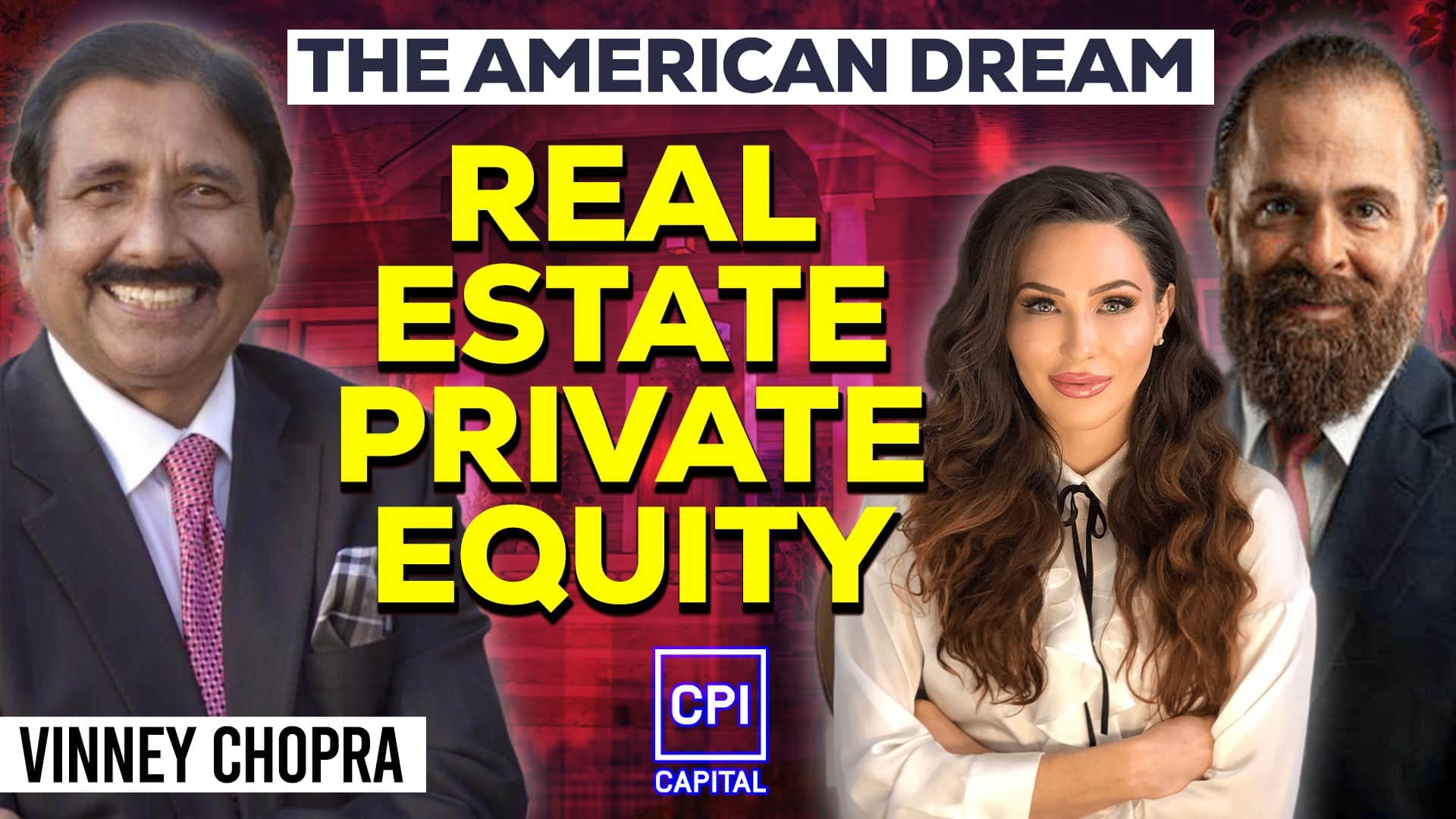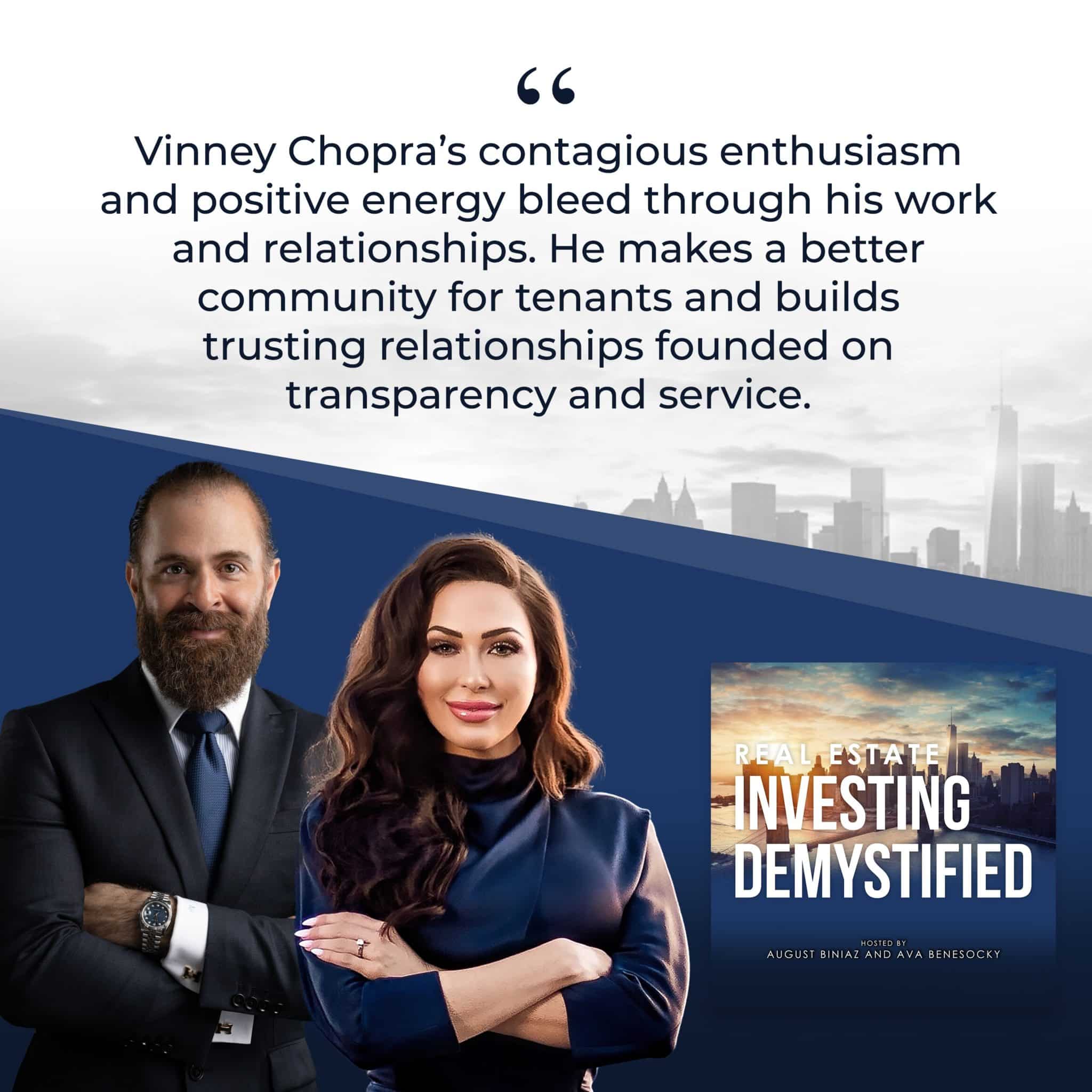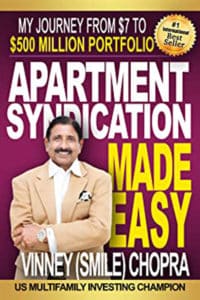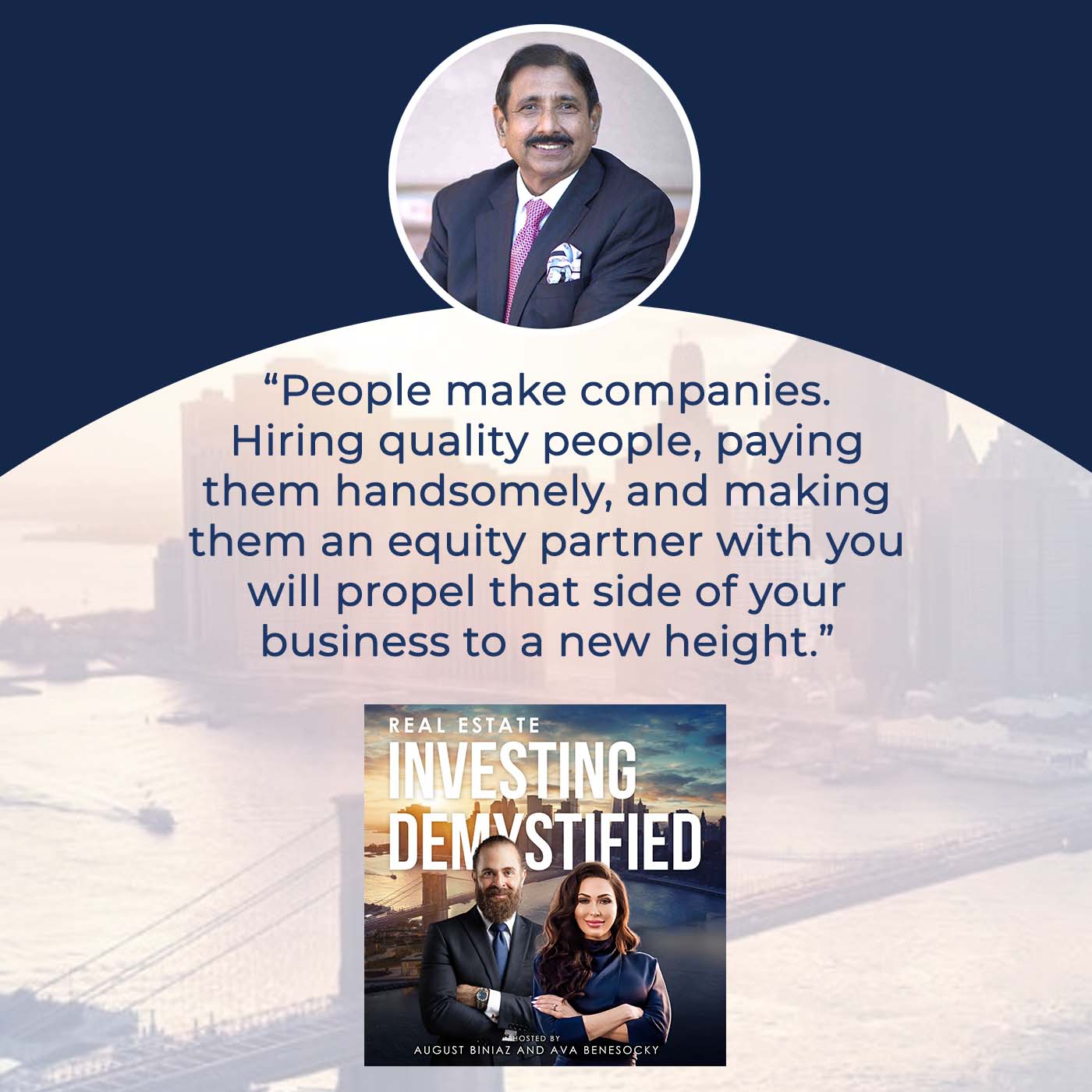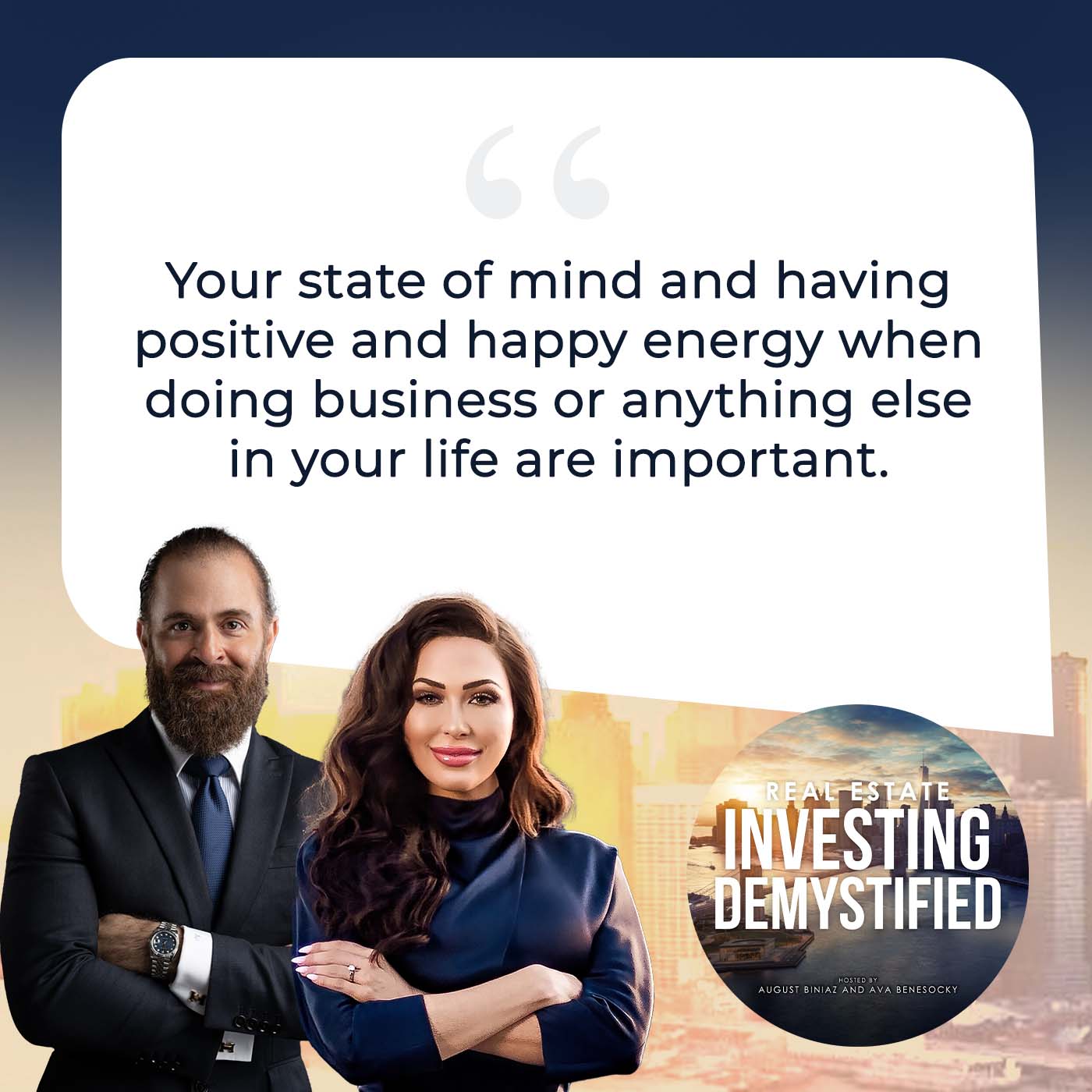Investment opportunities are ever-present, but which investment is wise for you and your money? Here to discuss real estate private equity is Vinney Chopra. Vinney is a real estate investor, syndicator, international best-selling author, multifamily educator, and mentor. He may be a multi-millionaire now, but Vinney started out with only $7 in his pocket. Now, he is helping others achieve similar success with the wisdom and knowledge he’s built over his decorated career. Tune in to this episode to get expert tips and strategies to help you in this venture. He discusses his journey from investing in single-family to multifamily and now venturing into raising capital with investors, helping them build their financial freedom. Don’t miss out on expert advice to guide your next investment.
Get in touch with Vinney Chopra:
LinkedIn: https://www.linkedin.com/in/vinney-smile-chopra/
Websites: https://vinneychopra.com/, https://moneilinvest.com/
Get a copy of Vinney’s book, Apartment Syndication Made Easy, on Amazon:
https://www.amazon.com/Apartment-Synd…
If you are interested in learning more about passively investing in multifamily and Build-to-Rent properties, click here to schedule a call with the CPI Capital Team or contact us at info@cpicapital.ca. If you like to Co-Syndicate and close on larger deal as a General Partner click here. You can read more about CPI Capital at https://www.cpicapital.ca. #avabenesocky #augustbiniaz #cpicapital
—
Watch the episode here
Listen to the podcast here
Important Links
- Vinney Chopra
- AppFolio
- Apartment Syndication Made Easy.
- Hampton Manor Premier Assisted Living & Memory Care
- Moneil
- Think and Grow Rich
- How to Win Friends & Influence People
- The Magic of Thinking
- The Miracle Morning
- The Miracle Equation
- The Power of Now
- A New Earth
- Built to Last
- YouTube – Vinney Chopra
- LinkedIn – Vinney Chopra
- Facebook – Vinney Chopra
- Vinney Chopra – Amazon
About Vinney Chopra

With a bachelor’s degree in mechanical engineering, he entered The George Washington University to seek a master of business administration degree in marketing and advertising. He sold Bibles and educational books door-to-door to support his studies, excelling both in the classroom and outside because of his work ethic and overwhelmingly positive attitude.
There’s a reason Vinney’s nickname is “Mr. Smiles,” which is evident even through just hearing the demeanor in his voice! He has always believed in individuals’ ability to shape the world around them through positive thought and selfless actions, and he has been a passionate motivational speaker and teacher for over three decades. After getting a taste of sales and marketing while pursuing his MBA, Vinney decided to leave engineering altogether and become a motivational speaker and fundraiser. He worked tirelessly to build clientele that would work with him annually to raise the funds to meet their goals and dreams.
The American Dream – Real Estate Private Equity With Vinney Chopra
We have another incredible show for you. Please like and subscribe as it helps us build our channel and allows us to keep bringing you great content and expert guest speakers. Our mission is to empower investors to earn passive income through real estate investing. We are joined by Vinney Chopra. Vinney Smile Chopra is a real estate investor, syndicator, international best-selling author, host of four podcasts, a multifamily educator, mentor, a dedicated husband of over 40 years, and a father of two children, Neil and Monica.
Vinney came to this country with only $7 in his pocket and a dream. Vinney now has built a portfolio of over 4,500 units amounting to over $440 million in multifamily, senior living, and hospitality arenas. He is passionate about helping others achieve financial freedom and giving back to our seniors who have given us so much.
We believe that Vinney will bring tremendous value to people who take life and business too seriously and don’t smile in the process. Also, he’s going to bring great value to passive and active investors who can take pointers from Vinney on all topics related to real estate private equity and how to be a great mentor. Welcome our friend, Vinney.
I’m excited. I can’t hide it.
Vinney, it’s great to have you on our show. We’ve been excited to have you. Maybe you can please start by telling us about your background and how you got started in real estate investing.
I’m from India, originally. I came to this country with a dream and with a little bit of money. I’m a mechanical engineer. I always wanted to be breaking all the toys when I was young and growing up to see what was inside. I came to George Washington University and did my Master’s in Business Administration Sales.
I happened to be invited to go sell books door to door. That’s 80 hours a week, knocking on doors and walking all day long to sell encyclopedias, children’s books, and Bible even. I’m a Hindu, but I sold Bibles. They’ve started a Bible home religious library around Atlanta and Pulaski in South Carolina. For three summers, I did that.
I got married. I’ve been happily married for many years. We live in the Bay Area, San Francisco, and Danville, Blackhawk area. We have two children, Neil and Monica, our pride and joy. Neil went to Berkeley. He did EECS, Electrical Engineering Computer Science. Monica went to UCLA and did political science and MBA like dad. She’s now our VP of Operations in Investor Relations. My wife is also involved. I’m involved a lot with all the companies.
It all started with single-family homes like the majority of people do. We found out soon enough, after 35 years of investing in single-family homes, that we couldn’t scale up that fast. Over sixteen years back, I became a broker. I’m a California broker, a real estate broker. Even now, I’m active, but I never sold or bought anything.
I became an investor. I could talk to brokers in their language when I went to Georgia, Texas, Florida, Michigan, and all over the place. That’s where we discovered, “Let’s go to the commercial space.” Multifamily caught my attention years back. That’s when I spent a lot of time and energy and money and even coaches and mentors to learn the tricks of the trade. I didn’t know anything about LOI. I said, “What is that?” Letter of intent. Cash on cash, I didn’t know anything. Now I teach.
What you say resonates here because it’s a consistent story that we hear from our friends in the US, active operators who started out in the single-family space buying single-family and scaling their business and realizing that, at some point, it didn’t make sense. They then moved on to commercial real estate, multifamily in particular.
Unfortunately, where we’re located in Vancouver, Canada and also in other larger cities in Canada, it’s difficult to invest in single-family because the single-family prices are so high and there are not many options. The median home price at $1.3 million here in Vancouver and similarly also in Toronto, it’s difficult to buy a single-family and create a business out of it.
Furthermore, because of the extremely low rent-to-value ratios, if you buy a single-family as an investment property, the rents are so low that you can’t even pay your mortgage payment. That’s a difficulty that Ava and I saw right away, the pain point for investors. That was our impetus to start in the multifamily space. I just wanted to jump in and say that.
That definitely is a big desire to invest in the USA market, limited partners, or general partners.
Maybe you can tell us about your start in multifamily. Why did you believe in this asset class so much and why do you believe in this asset class?
It’s amazing because we were having so many single-family homes and many roofs to take care of. Of course, each transaction is a different loan from the bank, so you’re limited to how many single-families you could buy and rent. You then have all of the different states. Different property management companies are hired to manage them out.
When I was introduced to the idea to get 20 homes into 20 different dwellings in one area, 20 units, let’s say, only 1 or 2 roofs to take here, and one transaction. The scalability is there. We can also say economies of scale and having a part-time manager to take care of collecting the rents. Getting away from the toilet trash and tenant situation, that’s when multifamily made sense.
The other big factor was the vacancy. In a single-family home, if somebody leaves, you’re 100% vacant. You have to turn the unit. You have to pay somebody to lease it up again. You lose so much time in 20, 30, or 100 units. Now we are buying 400 units. If only five residents leave, there are so many leftovers. Almost 95% is still occupied. The risk is much less in multifamily as compared to individual assets.
The risk is much less in multifamily as compared to individual assets. Click To TweetNot only on the active investor side groups and teams like us but also on the large institutions, they love multifamily. Multifamily seems to be this wealth-building machine that even institutions invest into. We bring in the value and components. A lot of institutions, when they do buy multifamily, there is no value. They park their money there in market appreciation and cashflow.
They use it as a hedge against inflation.
Value add is a big function in the multifamily. In the early years, I couldn’t raise much money. I was buying C-Class, C-minus, C-plus, and B-minus. There are so many different classes. As we can raise more money, getting into a B-Class, B-plus, or A-minus is a tremendous opportunity for risk-averse. Passive investors can realize great gains.
The business plan calls for increasing the rents, reducing expenses, and doing cost segregation, that’s a huge one, to get all these paper losses. The whole LLC is positive, making a ton of money. Investors are getting paid. When tax time comes, it’s a pass-through entity. All the cost segregation, big dollars in the negative, makes the whole LLC look like it’s in loss, but it’s making money.
There are so many incredible benefits for multifamily.
The same thing for our Canadian investors as they invest with us because of the flow-through concept that you mentioned, Vinney. Also, they are able to get cashflow and the cashflow is tax-free until the capital event when the asset is eventually sold. Interesting items here.
Waterfall too. Once we have increased the value so much of the asset, I love that and then you notice the dead money, dead equity. You can refinance, get a new loan, have a waterfall, and give some portion back to the capital.
To the investors.
That point is very important. A lot of people who are not very sophisticated when it comes to real estate investing, particularly multifamily, have this misconception that multifamily is assessed the same as single-family. That’s not the case. These multifamily assets are looked at as purchasing a business like a business. An important number is NOI. If the NOI is there, depending on the cap rate, that’s what constitutes a price for an asset. Vinney speaks about increasing that NOI. When we come in, it’s to increase the asset value. It’s truly a tremendous process.
The revenues could bump the rents with force inflation like that. Also, providing more service to the residents as we take over and then renovate. Bumping the rent will help revenue increase. We get ourselves to reduce the expenses. The property taxes, if you can contest them, the insurance is a big one. Of course, the administrative costs and other marketing things increase the total debt effect of the revenue minus expenses NOI. The best thing is, when we buy in the good areas where the compression of the cap rate happens, it’s an amazing equation.
Listening to Vinney speak, this is the type of general partner you want to partner with because he comes up with creative ways to increase the value of the asset. That’s what limited partners want to look at, a GP who comes up with creative ways to increase their asset value and, in turn, give bigger checks to the investors.
I would love to give a couple of examples, if I may. We purchased a property for $34,750,000 in the domain area of Austin. Austin is on fire, as you all know. We bought a property in Princeton Park in Florida near Melbourne. We were collecting 98% of the rents even when COVID happened. Mind thinking, you say, “Engineers, all of them, nobody’s leaving.” I said, “Let’s go to Austin,” that was coming home for me.
I was in Austin years back. I bought lots of properties in San Antonio and San Marcos and I sold them. This one asset that you bought, it’s ours now, Renaissance Park, 308 Unit. The broker remembered. He says, “Vinney, I know you.” I said, “What?” The listing broker says, “You were the easiest guy to work with.” I said, “What are you talking about?” Michael was able to tell the seller, “Vinney, I know him.” Fifteen bidders and we lined up the deal.
We closed it in 56 days. We got 2.68% interest from Freddie. Fannie and Freddie were fighting to give my partner and me the loan. We got 2.68%. The best thing is we bought it over a year back and it’s gone in value by $12 million. You might say, “Why?” It’s because the cap rate was reduced and we increased the NOI.
We’re talking about those two things. We got 413 a door. Now they’re underwriting 153 a door down the road. It’s amazing. With limited partner investors, I could make a bundle of money, which is exciting. In over fourteen years, I’ve never bought a property that increased by $10 million to $13 million. It’s almost 33% in one year.
That is amazing. As a general partner, Vinney also goes in there and makes a better community for the tenants to live in as well. I wanted to point that out as well because you have that under control.
We put the fence around the pond. We have a leasing office. We already have a good game plan. Also, 104 units out of 308, we’re going to renovate them. All those things are going on. Simultaneously, the signage changed. We have to let the passive investors because it’s their hard-earned money.
Let’s talk about passive investors because the relationship between the GP and LP is very important.
Us being in the real estate private equity space or others like to call it estate syndication space, we’re the stewards to our investors. The investors put their trust in us to find the best investment opportunity and manage that investment opportunity correctly. Maybe you could tell us about this close relationship with investors.
That has been taught to me. We have a fiduciary responsibility towards taking care of the money of the investors better than our own money. That’s how I say it. Also, transparency, opening up and educating the passive investors. I love to do this. Once we close the property, we meet in one month in a Zoom meeting.

Real Estate Private Equity: We have fiduciary responsibility towards taking care of the money of the investors better than our own money.
We invite all the investors of that property and go over the closing statement, line by line. We make sure that the investors see that we purchased the property and bring the personnel. They have pictures, “This is our community manager. This is our leasing, agent, or assistant manager. This is our HVAC certified technicians.” All those things are important to bring the property to investors in a quarterly meeting.
In the first part of the acquisition, I do it every month or every six weeks to let them know that their money is put to good use. We record them and then we send the link out to all the investors of that asset because not everybody can come. It’s an open platform. They could ask any question about everything. We also bring brand new pictures of the asset, which we have traveled there and all. We bring the asset to the passive investors during quarterly meetings and things like that.
We have a portal, of course. We use AppFolio. It’s a great investor portal where our investors can log in and they can see their money in every asset, how much they put in, and how much they have gotten back already in the cashflow. Every quarter, it’s updated. If we have given them the capital back, they can click on the document side and look at each property’s pictures and newsletters. They could look at the K-1s when they get to that thing.
How about cultivating and nurturing relationships with investors?
To add to that, a lot of times, we do a lot of work to go out there and meet people at different events. We create educational content. A connection is made. We’d be happy for you to talk about how you make those connections. It’s also important to nurture those relationships. Different operators do it by sending lots of free content. Talk to us about how you go about cultivating and nurturing relationships with investors, Vinney.
Let’s look at the psychology of the investors. Passive investors use their hard-earned money, whether it’s $200,000, $500,000, or $1 million. Some of our investors now have close to $4 million with us in different assets. One investor only. They tell their relatives, friends, brothers, and sisters. Our whole 400 investors circuit is pretty strong and tight. They haven’t come from outside social media or like that. They have been building with us over the years and got 20%, 30%, or 40%.
I’ve given the highest IRR of 43%. That means, with cashflow and equity gain every year, once we sold the property, they realized that for six years, if they gave me $100, they got $40,000 back each year. We had some good runs. We can have a big run on the Austin property. We are planning to sell our Bentley. Over two years back, we bought it for $52 million. That is going for $67 million. We purchased it for $52 million over two years back. That’s $15 million more.
Off-market, people are talking to us, “Can we take it from you beforehand?” We are out in the open in about two weeks or so anyway. Princeton, we’re going to keep. The key thing is to buy right. I believe that. Don’t go for manipulating the underwriting psychology. I have a very strong underwriting template that I have honed in and lots of different formulas and all. We’ve got to take care of the actual numbers and be conservative in assumptions.
The key thing is to buy right. Click To TweetThe OMs are printing memorandums. Sellers and brokers want to make it the best of the best and give you all these different rosy pictures. You’ve got to figure out, “Are these two assumptions or not?” How would you run the asset? What will be your business plan? All those things. Having the newsletter is important, by the way.
We are even now giving a five-page newsletter to the investors every month on these big assets because a lot of money is tied up. $60 million in one asset. $40 million in another one. $70 million in another one. We have investors who feel good about reading and seeing, “This is the real deal on what’s happening with my money.”
A quick question for you, Vinney. On these assets that have performed so tremendously well, as a general partner and a sponsor, how do you go about making a decision between refinancing or exiting the asset? How does that come about? Talk to us about that process.
The thing is I have always felt that the cheapest money is the lenders’ loan, brokers’ money, bank’s money, Freddie and Fannie money. If I can give a cashflow of 7%, 8%, 9%, or 10%, but my loan is at 2.69% or whatever it is, the margin is spectacular. When the money is in the property as debt-equity, it decreases the balance due. That’s all it is. You’re going to wait for seven years to sell it at a high price but then pay off the loan.

Real Estate Private Equity: When the money is in the property as debt-equity, it’s just decreasing the balance due.
If the property’s making good money and there is cashflow, it can take care of the excess mortgage. There is a first mortgage and there is a second mortgage for the refinance dollars. If that makes sense, we bring it to the investors in the quarterly investor meeting and then we share with them, “This is where we are. The value has gone BPO.” We call it broker’s price opinion or brokers opinion of value, BOV. That way, we can find out a rough estimate because an appraisal has to be done.
Once we have that delta, we could go to the investors and say, “Is it okay if you could do a waterfall?” A waterfall is not a taxable event at all because you’re refinancing and you’re not selling. The selling of the asset is a taxable event. That way, the return of capital is not. They can get that money and even give it back to you again in another asset. They are owning this one and the next one. In my lifetime, we had three assets like that where we returned every dollar to the investors. They were making cashflow with zero investment. Cashflow divided by zero is infinity. They were making infinite percentage.
I want to talk about the book that you wrote, Apartment Syndication Made Easy. Maybe you could talk to us about the idea of writing a book. How did it come about and maybe a bit about your journey in writing your book, please?
I was getting overwhelmed, to be truthful. Syndication can be very overwhelming with all the moving parts from dealing with the brokers, finding deals, underwriting, and the loan process. You’re doing the qualification and the due diligence. You’re going to be putting your signature on millions of dollars. Loan qualification is a big process. Not only that, you usually have only 60 to 90 days to close on a deal. Having an investor base is a huge part of the big thing.
If you can go to the property and the investors’ equity doesn’t come on time, we’re in trouble. There are lots of different things. That’s why I broke it down into five plates. I used to get mesmerized by his jugglers in India. I took that analogy and I wrote it for myself, to be truthful. Thank goodness, it became an international top seller. People liked it.
The key thing is it simplifies the process. A lot of people are able to go from there into my academy, where I teach. I usually teach for two hours. We have been recording thousands of hours of lectures. I have an online academy also where people can go to the academy. Without even conversing, they could do everything I’m doing.
That leads me to my next question for you. How do you balance your time and energy and dedicate the needed amount of time to focus on all these different platforms you’re concurrently managing together? You have your YouTube show, your podcast, your company, and of course, your beautiful family. How do you manage multitasking all these things?
Thank you. What I find is that I believe in prioritizing, everybody does. Delegating is my second thing. Mindset is my third thing. I always had a card right there on my desk, “You got to prioritize.” Many times, you spend a lot of time in the Cs, Ds, E’s, and Fs. If I can take care of A’s and B’s and then delegate the rest, that’s the best thing.
I always have to say that hiring the right people is the best thing. People make companies. Buildings don’t make companies. That’s how I look at it. It’s not the system. It’s the people. Quality people, pay them nice and handsomely. Make them an equity partner with you. This way, they will propel that side of your business to a new height, like senior assisted living. I was sending out messages in the universe, “I need a partner who could take me into senior living.” That is where the silver tsunami is going through right now.
Let me jump in here if you don’t mind. Senior living was an important topic that I wanted to cover. Your background is in single-family. You moved on to do multifamily investing. You’ve done tremendously well. At some point, you have pivoted to focus on senior living and assisted living. You’re also doing very well in that sector as well. Talk to us about what was it about senior living and assisted living that interested you? Tell us more about this asset class. Why is it that you were making a point a moment ago? Tell us more about this asset class, please.
Thank you. There are three ways they are going through in the USA and around the world. One is Millennials, the Z, X, and Y. They are not liking to buy homes, but they’re renting with nice amenities and all. That’s a big wave, which we want to be on, conventional multifamily and all. The second one is the immigration wave where they can’t afford so then they will be also renting, which is where the jobs are and everything.
The third one is the silver tsunami wave. The silver tsunami is prominent here. 10,000 Baby Boomers are turning 65 every day. We are $54.7 million 65-plus in the USA. Across the world, it’s a big population too. Also, 10,000 more are added every single day, which is increasing 70 years higher or 85 years higher every day.
In senior living, there are about five different ways you could tackle that market. One is independent living in which no assistance is needed. Also, golf courses and all. You know how people have small investments if they need some prescriptions or transportation. Those are great. No limited need driven is not there.
In the middle, there are two different kinds, assistant and memory care. If somebody has a slip and fall or one of their partners passes away, their life starts going down or they cannot cook and things like that. That’s where we felt our soft spot. I’ll share with you how I got in there. The right side is strictly need-driven. Those are rehab centers, nursing homes, hospitals, and things like that. We are not in that business at all. We are only in assisted senior living and memory care.
I send the signals out. I came from India at 22. My partner came from Pakistan at the age of seventeen. He was selling medical supplies to senior living and assisted living. He would cry at home about the pathetic situation, the smelliness, and what they were feeding. He got angry. He says, “I’m going to start building from scratch luxury senior living.” Over three years back, that’s when we got connected. Now, we are joined at the hip. We are building. Our goal is $2 billion of construction and managing and doing all these purchases of senior living.
We‘ve built 5 to 7 acres of land with 4 to 6 courtyards where people can walk. One story, no elevators, and it’s got dining halls with high ceilings. It’s got spas, salons, movie theaters, libraries, billiard rooms, grand pianos, you name it. It’s got potting greens and swimming pools. Those are the ones we are building. We are moving to the states like Florida, Texas, Arizona, and Virginia, where it’s warmer climates. A lot more seniors are moving over there. That’s how I got started.
This is a ground-up development project. You’re building from the ground up. You’re targeting regions where there’s a migration of seniors with warmer climates. Talk to us about what is the timeline from the start for people to come in and to be able to live in these properties?
We started from scratch. In other words, after we do the capture rate study and look at what’s available in that community, we buy the land. We meet with the brokers. We buy the best land patch, 7 or 12 acres even, which is near to the hospital and all those things. We then do ordinance changes because we have to go to the city house and all to the building department. We give the architectural drawings of what we are trying to do. That takes us 6 to 9 months, by the way.
We do it on our dime. My partner and I network and everything. Once we have all the permits, we get the construction loan for about a year or eighteen months and then we start constructing. We have general contractors. We’ve done it 23 times already. It’s a cookie-cutter thing. All the interiors look the same. Everything looks the same. Hampton Manor Premier Assisted Living & Memory Care is our brand. That’s where we are able to build it strongly with all brand new, A++ luxury items. Different maintenance on this multifamily is zero because we built it. It’s an A++ class.
When it’s about 65% to 70% built and we have banners outside, we start building the website and do the application processes and due diligence on the residents who will be moving into it. Our goal is to have 50% occupied the day we even cut and open it up. The break-even point for assisted senior living is very low, by the way. The percentage occupancy is 52% to 57% as compared to 77% in the conventional multifamily.

Real Estate Private Equity: The breakeven point for assisted senior living is a very low percentage occupancy. It’s 52% to 57% as compared to 77% in the conventional multifamily.
We love that fact. We build only 88 to 92 units, no more than that. We don’t want it to be a commercial 2-story or 3-story. We don’t believe in that. We want our seniors to go out in the yard, plant some vegetables and fruits, have good air, and do activities of daily living. Of course, we have spas and a movie theater. It’s a community.
It’s different from multifamily, where the residents get into the unit and then they go to work and come back. These are the residents who are there 24 hours. We have caregivers 24 hours. We have one nurse available. There are no doctors in our case. We don’t need doctors, medical equipment, or whatsoever, only dispensing of medicines, which are locked. We have software for all that.
Being an active investor, in my perspective and one of the reasons I fell in love with multifamily was that the management could be contracted out to property management firms. Some sponsors also have property management. They’re vertically integrated and they have a property management team in-house. In most cases, the property management is contracted out to a third-party property manager in multifamily.
With assisted living, this concept where you were talking about the nurses and other employees, common sense tells me that that’s not something you could subcontract out to someone else. Does that make the process of management of such facilities more cumbersome and difficult? Talk to us about that and how that all works.
We are vertically integrated. In my lifetime, I started a partnership with a person and we had an acquisition company and a management company. I then started more Moneil, which is our kids’ name, Monica and Neil. We started that in 2014. Our company, the new one, has taken strides. That was also vertically integrated. We always manage.
Now we have sold assets, so we have gotten belt partners, wonderful people. They manage 70,000 doors. Now we have ramp partners in Tennessee who are also going to be managing. We’re going away from the conventional managing side. In senior living, we feel we could do the best experience if we manage ourselves.
We have our own directors, personnel, and chefs that we hire. Everything is vertically integrated. We are managing 14 centers, 14 communities. There are some operators, by the way, that you could give to your already built assisted living senior care to an outside company. There are companies like that. We want to build our own brand, Hampton Manor, and that’s what we are doing.
I’ll get to my next question here. I was doing some research. I’m always trying to educate myself on multifamily and real estate private equity. I stumbled on a video with you and a fellow named Corey on YouTube, which someone you mentor. Talk to us about that. As you say, generations change for you. You now have your daughter involved in your company as well. How do you go about this concept of mentoring others and passing your education to others that are looking to come up in this space?
Giving back to the community has given me so much and that’s why I started. I was answering a lot of questions from a lot of investors and I was answering them the same way. I was repeating myself. Years back, one of my good friends said, “Vinney, start recording. Start doing everything.” I’ve recorded thousands of lectures now on all aspects of what I do in a practical way. I put it into an online academy so people can go to everything and get all the ducks on a silver platter, everything I’ve designed to the online academy.
The second level is where they get group coaching from me, which is every Wednesday from 4:00 PM to 6:00 PM. We meet and you could bring your deals. We can go through putting holes in there. You could have questions. It’s an open forum. We have certain guest speakers coming in and doing coaching. We record them too, all of them.
The third one is personal coaching, where I do it one on one to move people to syndication. Some people have done it in three months, 2, 3, or 4 syndications. It’s amazing. Those are the three levels of my academy. I love it. I don’t have coaches. It’s my passion. I like to deal and so forth. It’s not a big segment of my business. I like to just give back.
We’ll be wrapping up pretty soon here, but we have a couple of more questions for you.
Vinney, I love that your nickname is Smile. In every one of the videos we watch, you’re always so enthusiastic and full of this life and energy. Maybe tell us about the state of mind and the importance of having positive and happy energy when doing business or anything else in your life.
It helps so much. That’s why I wrote this book. I’m doing a revised edition to this one. The book came out okay. I want to put more into it. The key thing is it’s all the mindset. You could learn so much. If the mind is not right, we won’t be able to move faster on the track to success or whatever goals we’re setting for our lives. Mindset is the big thing. 80% or 90% of the things happen right here whether bad or good.
You could learn so much but if the mind is not right, we wouldn't be able to move faster on the track to success of whatever goals we are setting for our life. Click To TweetI used to be okay. I was a goal setter when I was young. When I came here to the USA, I read books from Napoleon Hill, Think and Grow Rich, How to Win Friends & Influence People, and The Magic of Thinking by David J. Schwartz. There are so many books and podcasts. We should be putting more money to train and put the best things over here like we put so much money underneath. From the mouth down, we love to have steaks and spend hundreds and thousands of dollars. We should be investing in ourselves from the neck up. Zig Ziglar says, “Thinking between the two ears.”
No one has to make a decision internally. Externally, people cannot change people. I cannot change anybody. If you make a decision, “I want to be a little bit more positive. I’m going to look at the spin of positivity into everything.” A silver lining on a dark cloud, as we say. I read The Miracle Morning. Hal Elrod, our friend, wrote the book. The Miracle Equation is another one. Also, Eckhart Tolle’s The Power of Now and A New Earth. There are so many great books out there that can set our minds right. If the mind is right, if we are right, the world will be right.
Thank you so much for sharing your knowledge with us, Vinney. We appreciate you. We’re excited to start the next segment of our show with you as well and that’s going to be The Ten Championship Rounds to Financial Freedom. I’m going to ask you a list of questions and whatever comes top of mind first. We’re going to get started. Who is the most influential person in your life?
I have met a lot of mentors. All these people I talked to didn’t know me. Another gentleman, a billionaire, Spencer Hays, has been a great influence in my life. He was an executive director, owner, and billionaire. Also, my grandpa lived to 94. Also, my grandpa from my dad’s side. Those are my great mentors.
This is going to be a good one. What is the number one book you’d recommend?
I would say The Power of Now. I don’t know why. Eckhart Tolle’s books, everybody should read. Even our children, Neil and Monica. We bought that book and had 3 or 4 copies lying around in the house. We knew they would read it. That’s a great one.
If you had the opportunity to travel back in time, what advice would you give your younger self?
I was a motivational speaker for a long time. I stayed with one company. My stake shares went 600% and 700% up, which is good, but then I put a lot of toil into it. I would have gotten into real estate quicker instead of fifteen years. For multifamily, maybe earlier. I never repent on anything, even 30 seconds back, because I cannot change it. I concentrate on today and tomorrow.
What is the best investment you’ve ever made?
Marrying my wife. She’s been a blessing to me and our two children. Family is the biggest blessing I can really be grateful for.
What’s the worst investment you’ve ever made?
I’m sure there are lots of them. I’m a shopaholic. I love to buy clothes and things. I lost money in the stock market, $791,000. I remember the crash of 2008. Maybe if I had more knowledge, I should have pulled that money out.
How much would you need in the bank to retire today? What’s your number?
I’ve passed that number many times over. Maybe $10 million is a good number. Of course, if you want a more lavish style, $20 million or $30 million. Mine is $100 million now but let’s see.
If you could have dinner with someone dead or alive, who would it be?
I have so many great mentors. I would say somebody who can uplift me and give me some great advice, which I can hone in. I believe in the books we read. If we don’t implement those good things we learn into our life, there is no reading. I don’t know if I can think of one person, but I’m sure there’ll be several.
If you weren’t doing what you’re doing, what would you be doing now?
I’ll be doing exactly what I’m doing today. I will be 70 years of age in 2022. I just turned 69, but I feel like I’m 26 or 29. It motivates me to give back. My goal is $2 billion, which is a big goal. We have big, hairy, and audacious goals in the Built to Last book. The thing is, if you send those signals and you can get some great partners who can bring equity and the construction, we could start 30 projects in a year.
Book smarts or street smarts?
Street smarts. The thing is, we got to learn from the books and apply them. Move the needle. I talk to my students and investors all the time, “What did you do last week from last Wednesday to today?” I’m going to be asking you, what did you do? How many investors did you talk to? How many brokers? How many deals did you underwrite? If you’re doing W-2, how much time do you spend? We got to move the needle towards the goal.
Last question. If you had $1 million cash and you had to make one investment now, what would it be?
I have a lot of money now. We all have. $1 million, I’ll donate it. We raised money for Charity: Water. I’m going to be getting involved in some schools in Nigeria, India, and other places. When you have so much, how much do you need? It’s good to give back.
Vinney, you’re wonderful. Can you let everybody know what’s the best way to reach you?
My name is Vinney Chopra. You could google me. I have a YouTube channel. LinkedIn and Facebook, I’m there. Also, my podcasts. I have four podcasts if you’d like to listen to some of the ideas. If you go to Amazon, it’s Vinney Chopra. There are a couple of books out there. I’ll be putting the third one on senior assisted living. It will be awesome. We are coming out with that one.
Vinney, that’s a wrap. Thank you so much.
Thank you for coming on, Vinney. I’m sure people will gain a lot of knowledge from your wisdom and your experience. You’re always a joy to talk to in person and every time I watch your videos also. Thank you for coming on. We appreciate you.
Thank you for bringing such incredible energy.
Thank you, both of you. It’s such a pleasure we got together. You’re doing a fabulous job. I want to give you kudos. I see your beautiful postings and knowledge and everything. God bless you both.
Vinney, likewise.
